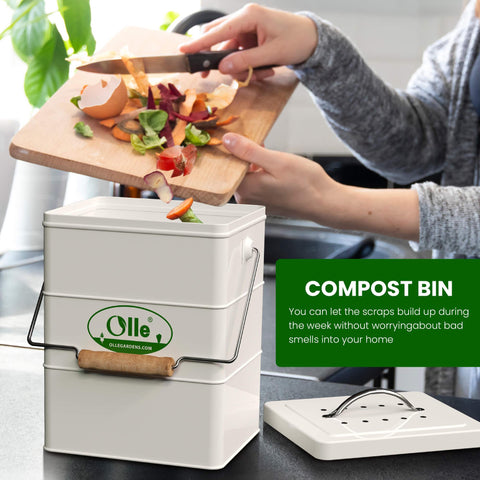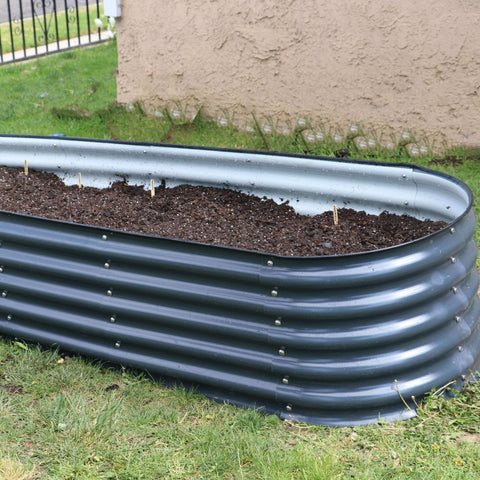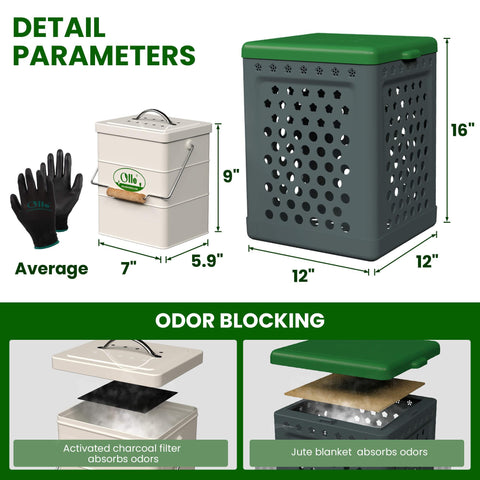Compost Bin Tips and FAQs from Olle Garden Bed
Composting is exciting because you are not only doing something good for the environment. You can also ensure the health of the garden! Who doesn't want to get high-quality compost almost limitlessly? This content also has some reference value for Olle Garden Beds.
Organic fertilizers such as compost are not cheap, so you can use or sell some useful things made from kitchen garbage. But before we enter, let's talk about the compost bin - what is the best size, what style to obtain, and what flipping technology to use to speed up the composting process.

Common problems about compost bin
Whether you buy a composter or make your own compost in the backyard, we know you have many problems! Now, let's try to answer some of the most frequently asked questions about compost and compost bin.
What size composter should I buy?
The size, size and depth of the compost box will affect the speed of microbial decomposition of organic matter. This is why it is important to know the ideal size of the compost bin before obtaining it. The optimal point is about 3 feet high, 3 feet wide and 3 feet deep.
The compost bin should hold twice the volume of finished compost you want, so that there is additional space when the material is decomposed. If the ideal size of the compost bin is not enough for your gardening needs, try purchasing another bin. You should also track the amount of kitchen and yard waste generated by your family within a month, so that you can create enough compost to meet your needs.
Which is better, vertical installation on the shaft or horizontal installation?
It really depends on your needs and personal preferences. Vertical composting is a trash can fixed vertically on the horizontal axis. This design allows you to turn the container using a turnover mechanism instead of turning the compost by hand. If space is a problem, it's a great design.
The vertical compost has a compact structure, so it is suitable for small living spaces. However, it does not have much compost. If you need more compost for soil improvement, this can quickly be frustrating. In addition, it is more difficult to turn the composter if it is full. This is not the most durable design.
The horizontal composter is similar to the vertical composter in design, but it is set horizontally. This makes the composter shorter than a vertical composter - good or bad, depending on your preference.

Just like the vertical composter, the horizontal composter can be rolled to turn over the compost. If you have more space for composting, this is a good composter. But just like the vertical composter, the horizontal composter can not hold much compost. If you add too much organic material to the container, you may damage the mechanism that rolls it.
Traditional compost bins, such as those provided by our store, are a good choice for gardeners looking for durable compost bins that can be used for many years. The compost bin may not have all the bells and whistles, but it can hold up to 80 gallons of organic waste. The bottom makes compost contact with the ground, so beneficial organisms can fully contact organic waste. This will accelerate the decomposition of organic materials and improve the quality of compost.
Should I put the composter in direct sunlight?
As long as the composter is made of durable materials resistant to UV damage, it can continue to be placed in a sunny place. Direct sunlight is beneficial to composting; It will accelerate the decomposition of organic materials. When the temperature rises, microorganisms and fungi in the compost will decompose organic waste faster.
That is, if you put the composter in the sun, you need to control the humidity level. Monitor compost to ensure that it is always wet but never wet. If it looks and feels dry, add some water.
Should I add water to the compost?
Only when needed, yes. Water is a key part of the decomposition process, but the amount of water should be just right. If the compost is too dry, the temperature will rise, killing microorganisms that break down the compost material. If the compost is too wet, microorganisms may drown. Too much or too little water will affect the decomposition rate of organic materials.
If the compost is too wet, turn it over or spread it on a tarpaulin and expose it to direct sunlight. This will dry the compost material. Another technique is to add wood material to a compost heap that is too wet.

How often should I rotate the compost drum?
This depends on the size of the compost drum, but you should rotate it three to four times a week. Check that the compost mixture is not too wet or too dry. If the tumbler is too heavy, place it in a horizontal area before rotating to avoid cracking and causing the entire mixture to overflow everywhere.
My compost drum is too heavy to rotate. What should I do?
If your compost drum is too heavy, you are loading it to its total capacity. This may strain the mechanism that secures the tumbler rotation. In addition, if the tumbler is too heavy, you will need a lot of elbow grease to rotate it.
If this is a recurring problem, we suggest buying another tumbler and distributing compost materials among these composters to reduce the burden. Or just make a small batch of compost, so that you won't eventually break the expensive new tumbler. A better option is to obtain traditional high-capacity compost bins.
One trash can can hold up to 80 gallons of organic waste. It is made of recycled and durable plastic materials, so you can make a large amount of compost at one time. Yes, you will hand in the compost materials manually, daily or regularly, but this is only a small part of the cost for a large amount of compost.

How do I add fresh material while waiting for the batch to complete?
Passive composting takes about a year to completely decompose organic materials. Adding fresh material to the compost will further slow down the decomposition rate, so remember one thing before trying cold compost.
To add fresh material to the compost, cut the material into small pieces. Use a pitchfork to place the new material in the compost until it is completely mixed. Check the moisture content.
My compost is moist and wet, and there seems to be no compost; What should I do?
If your compost is too wet, try adding wood and paper materials to the mix. This should help absorb excess moisture while maintaining a balance between green and brown materials. If this doesn't work, take a tarp and spread the wet compost in a uniform layer. Let it lie in the sun until the excess water evaporates, and then take the compost back to the bin or pile.
Are you ready to give compost a chance? It's easy to make compost pit. Try it
